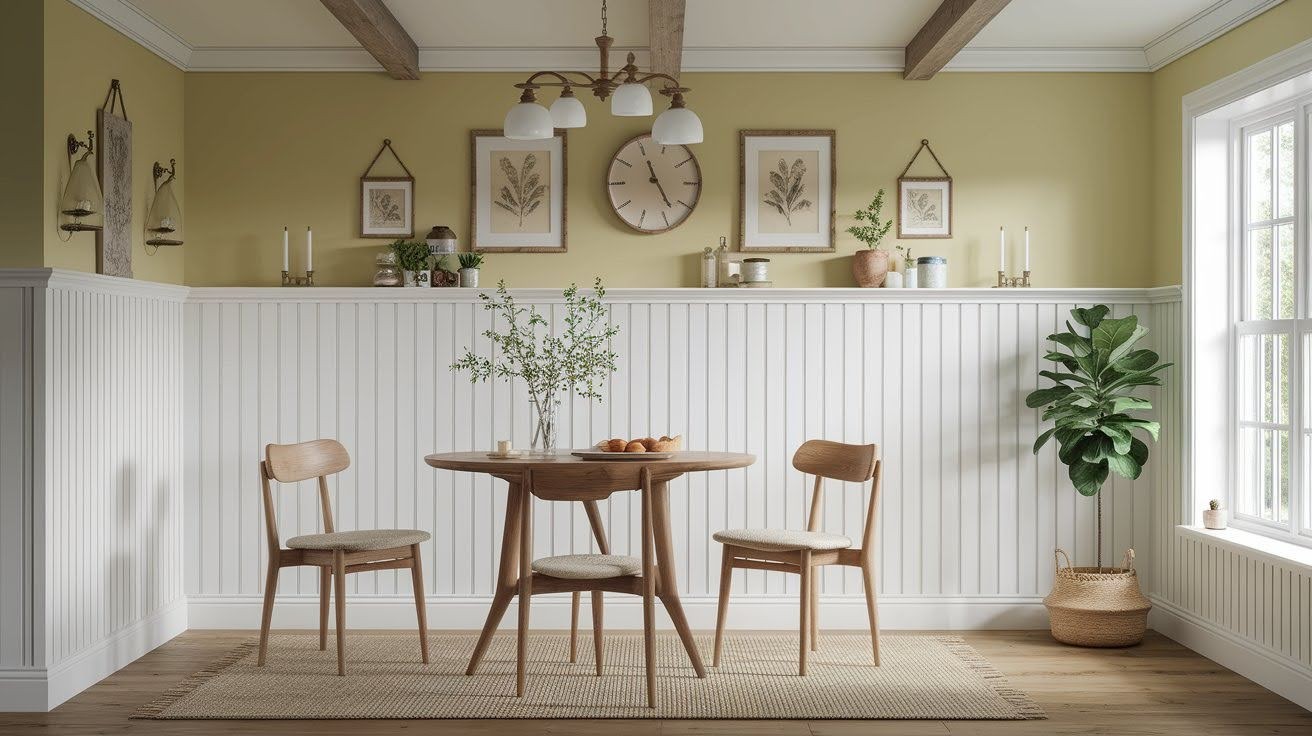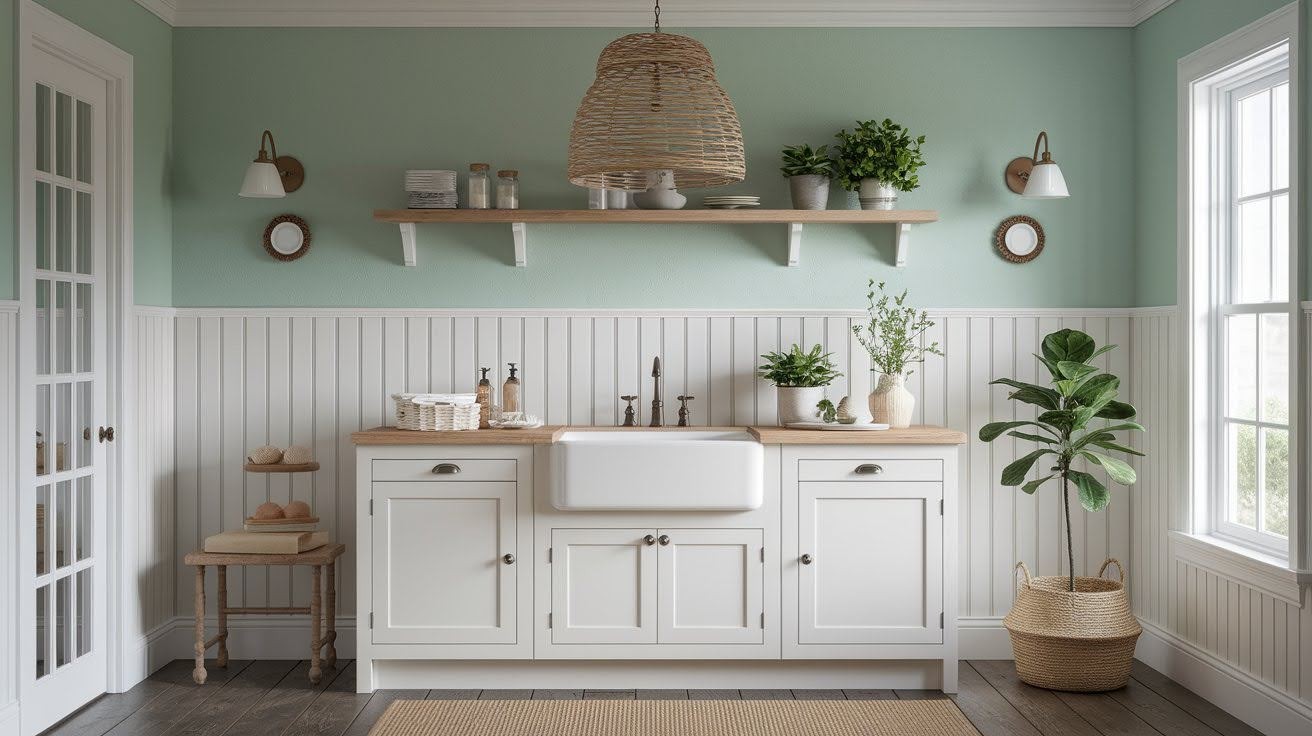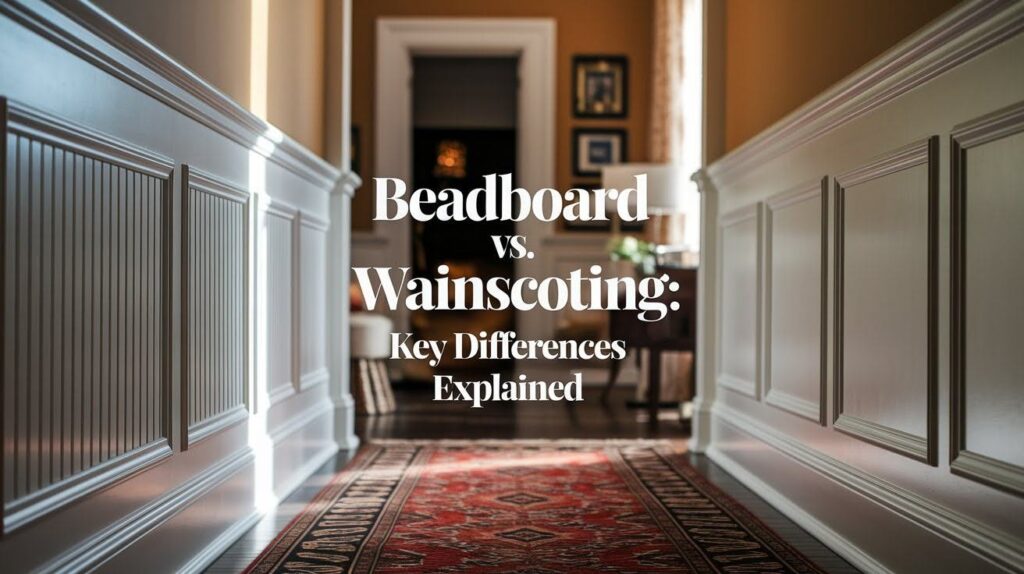Are you standing in the space of your living room now, staring straight at those plain walls, and do you wonder how to add some character without breaking the bank? You’re not alone.
Homeowners are scratching their heads each day about the beadboard versus wainscoting wall treatments debate.
Understand that they serve diverse goals because both choices reshape all of your space.
Budgetary concerns represent another point to contemplate.
In this guide, we’ll compare their costs, installation requirements, then break down the real differences between these popular choices and help you figure out which one makes sense for your home and lifestyle.
What Is Wainscoting?

Wainscoting is decorative paneling that covers the lower part of your walls. It typically runs from floor to about 30-42 inches high, creating a two-tone look that adds instant character to any room.
Features of Wainscoting
Height and Placement: Most wainscoting sits at chair rail height, covering roughly one-third of your wall. This creates balanced proportions that look natural.
Panel Types: You have three main options: raised panels that stick out from the frame, flat panels that sit flush, or board and batten with vertical strips covering seams.
Design Options: Customize frame thickness, panel sizes, and trim details to match your style. Keep it simple or add decorative molding for extra flair.
Benefits of Wainscoting
Protects Walls: Acts like armor against scuffs, dings, and daily wear. Saves you from constant repainting in high-traffic areas.
Adds Character: Converts plain walls into architectural features with depth and visual interest.
Boosts Home Value: Quality details like wainscoting signal craftsmanship to potential buyers.
Uses of Wainscoting
Formal Room: Perfect for dining rooms where you want an upscale, traditional feel.
High-Traffic Areas: Hallways and staircases get both protection and style without taking up space.
Entryways and Living Rooms: Creates great first impressions and makes spaces feel finished and cozy.
Bathrooms: Handles moisture well while adding spa-like refinement .
What Is a Beadboard?

Beadboard is wall paneling with narrow vertical grooves that creates a classic cottage or farmhouse look. Those distinctive lines running up and down have been adding charm to homes for generations.
Features of Beadboard
Vertical Groove Pattern: Thin ridges spaced every 2-4 inches create texture and visual depth through light and shadow play.
Installation Choices: Buy individual tongue-and-groove boards for authentic detail or large panels for faster installation.
Finish Options: Paint any color, stain to show wood grain, or apply weathered finishes for vintage appeal.
Benefits of Beadboard
Affordable and Simple: Costs less than most wall treatments and installs easily with basic tools.
Casual Style: Creates a relaxed, welcoming atmosphere perfect for cottage or coastal themes.
Adds Texture: Makes plain walls interesting without taking up space. Vertical lines can make ceilings look higher.
Uses of Beadboard
Kitchen Areas: Popular for backsplashes and ceilings in farmhouse-style kitchens.
Bathrooms: Works as a full wall covering or wainscoting when properly sealed against moisture.
Accent Spaces: Great for mudrooms, porches, and hallways where you want casual charm on a budget.
Beadboard vs Wainscoting: Key Differences
Here’s a quick comparison to help you decide which option works best for your project:
| Factor | Beadboard | Wainscoting |
| Style | Casual, cottage, farmhouse | Formal, traditional, upscale |
| Visual Impact | Cozy, relaxed atmosphere | Sophisticated, architectural |
| Material Cost | $1-3 per sq ft | $3-8 per sq ft |
| Labor Cost | $2-4 per sq ft | $4-8 per sq ft |
| Installation | Simple, beginner-friendly | Complex, requires precision |
| Tools Needed | Basic (saw, level, nail gun) | Advanced (miter saw, router) |
| Customization | Limited to groove patterns | High – panels, frames, details |
| Maintenance | Grooves collect dust | Flat surfaces clean easily |
| Durability | Good for light impact | Better impact resistance |
| Moisture Resistance | Good when sealed properly | Better due to fewer seams |
| Repair Difficulty | Easy – replace individual boards | Moderate – match existing finish |
| Best Rooms | Kitchens, mudrooms, bathrooms | Dining rooms, entryways, living rooms |
| Time to Install | 1-2 days typical room | 2-4 days typical room |
| DIY Friendly | Yes, great starter project | Challenging for beginners |
How to Choose Between Beadboard and Wainscoting

Your decision comes down to three key factors. First, match your room’s style and function. Casual farmhouse spaces work great with beadboard, while formal areas need wainscoting’s sophistication. High-traffic rooms benefit from wainscoting’s durability. Second, consider your budget and skills.
Beadboard costs half as much and forgives DIY mistakes, while wainscoting requires precision and experience. Third, think about coordination with existing trim and colors.
Beadboard works with most styles and hides imperfections, but wainscoting creates a more polished look when properly matched to your current architectural details.
Design Ideas Featuring Beadboard and Wainscoting

Creative ways to use beadboard and wainscoting in different rooms to add texture, visual interest, and classic style.
Cottage Look with Beadboard
Paint in soft whites or blues, install halfway up kitchen walls, and pair with open shelving for farmhouse charm.
Traditional Dining Room with Wainscoting
Use raised panels in rich colors like navy with white walls above for formal elegance that makes ceilings look taller.
Combining Both Styles
Install wainscoting in formal areas and beadboard in casual spaces, keeping consistent colors and heights for smooth flow between rooms.
Conclusion
The beadboard versus wainscoting decision hinges on lifestyle as well as budget. Beadboard suits informal rooms and DIY novices.
It offers a bit of cottage charm for around half the cost. Wainscoting offers formal sophistication. Yet, installation needs greater skill and investment. Walls gain protection, coupled with character is added in various ways.
Consider existing decor, skill level, and also your room’s function. Pick that which feels right as you trust your instincts.
Are you prepared to alter your walls now? You must start now to measure plus plan for your paneling project today.
Frequently Asked Questions
Which is cheaper, beadboard or wainscoting?
Beadboard costs half as much in materials and labor. Wainscoting requires a higher investment for materials and professional installation.
Can I install beadboard or wainscoting myself?
Beadboard works great for DIY beginners with basic tools. Wainscoting needs advanced carpentry skills and precision.
How high should I install beadboard or wainscoting?
Install at 30-42 inches high for balanced proportions. This equals roughly one-third of your wall height.
Which option works better in bathrooms?
Both handle moisture when sealed properly. Wainscoting has fewer seams where water can penetrate.
How do I maintain beadboard versus wainscoting?
Wainscoting wipes clean easily on flat surfaces. Beadboard grooves need regular brushing or vacuuming.

